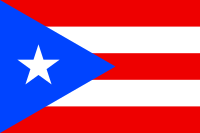Wikipedia:WikiProject Puerto Rico/Puerto Rican Independence movement
Ok here is what we got to begin:
Content of current Puerto Rican independence movement article
[edit]
The political movement for Puerto Rican Independence (Lucha por la Independencia Puertorriqueña) has existed since the mid-19th century and has advocated independence of the island of Puerto Rico, in varying degrees, from Spain (in the 19th century) or the United States (from 1898 to the present day).
There have been many types of fights for independence in Puerto Rico, some violent and others peaceful. In 1868, the Grito de Lares took place, in which revolutionaries took over the town of Lares and declared the Republic of Puerto Rico. Ramón Emeterio Betances was the leader of this revolt. The revolt was "squashed" by the forces loyal to Spain.
A number of other leaders, including Jose de Diego, a well-known intellectual and legislator had sought disconnection from the United States via political accommodation. Pedro Albizu Campos was an influential revolutionary leader in the early 20th century. He co-founded the Puerto Rican Nationalist Party, a group that used violent means in an attempt to gain independence from the United States. In the 1950s, the Nationalists staged an uprising in the island (The Jayuya Uprising); attempted to assassinate President Harry S. Truman at Blair House; and, in 1954, led an attack in the U.S. Capitol building that wounded several legislators.
Puerto Rico was allowed to have a constitution in 1952 under the U.S. supremacy clause, subject to U.S. laws and a U.S. Executive and Legislative Branch, which Puerto Rico residents did not participate in electing or creating. The government suppressed the Nationalist leaders and their activities and the influence of the Nationalist Party waned. A spectrum of Nationalist sentiments and parties exists nowadays in Puerto Rico. A majority of independentistas today seek to achieve independence through either the electoral or the diplomatic process. Gilberto Concepcion de Gracia founded the Puerto Rican Independence Party or PIP, the most influential organization participating in the electoral process. The party has successfully elected some legislative candidates, but has never won more than a few percentage points of the vote in gubernatorial elections (2.7% in 2004 [1]) or in referendums about the political status of Puerto Rico. Its leader is currently Ruben Berrios.
Content of current Latin American and Caribbean Congress in Solidarity with Puerto Rico’s Independence (this title is way to long) article
[edit]The Latin American and Caribbean Congress in Solidarity with the Independence of Puerto Rico consisted in an international summit held at Panama City, Panama. More than two-hundred delegates hailing from twenty-two different countries in the American hemisphere met on Thanksgiving weekend of 2006 (November 18-19) to discuss the situation. [1]
The Congress was organized and sponsored by Panama President Martín Torrijos’s governmental Revolutionary Democratic Party (PRD) and the Puerto Rican Independence Party (PIP).
In the words of President Torrijos, "Puerto Rico is to this day the only Latin American nation remaining under a colonial regime. From the perspective of Latin Americans, assisting in the effort to mend that anomaly is a matter of principles, a continental priority".
Torrijos stated that Latin Americans cannot continue being indifferent to said reality. Moreover, the aforementioned dignitary claimed that it is the duty of all Latin Americans to take part actively in its adequate solution.
Rubén Berríos, President of the Puerto Rican Independence Party (PIP), informed of a plan to create committees of solidarity with the island-nation of Puerto Rico throughout the dozens of countries of the region, which are spread throughout two continents (North America and South America, as well as in the Caribbean Basin region.
The Congress’ participants included fifteen incumbent-governmental parties that, together with dozens of other Latin American political parties, unanimously approved a Proclamation calling for the United States to immediately respect Puerto Rico’s right to independence and unabridged sovereignty. This proclamation quickly became known as the Panama Proclamation in international circles.
Also present to support Puerto Rico’s independence were Raúl Alfonsín, ex-President of Argentina; Tomás Borge of Nicaragua; and, Ricardo Alarcón of Cuba.
Sources:
[edit]- [2] Dominican Today daily newspaper
- . independencia . net/noticias/pl_ingl_congr_rejects_colol_status22n06.html Prensa Latina daily newspaper
- . independencia . net/ingles/p_procamation_LA_carib_Congress17d06.html Panama Proclamation - full text available to reado and/or print
Content of current Hostosian National Congress article
[edit]The National Hostosian Congress (Spanish: Congreso Nacional Hostosiano, CNH) was a small left-wing and pro-independence in Puerto Rico. Led by Héctor L. Pesquera, many of its members were formerly involved in the Puerto Rican Socialist Party. In 2004, the CNH joined with the New Puerto Rican Independence Movement to form the Hostosian National Independence Movement (MINH).
- ^ "Panama requests Latin America to support Puerto Rican independence". Dominican Today. 2006-10-19. Retrieved 2007-03-09.
